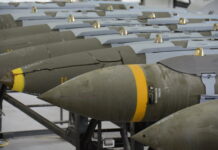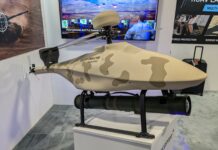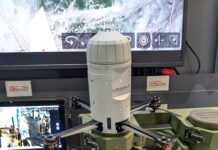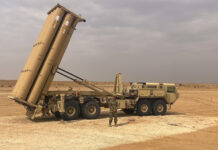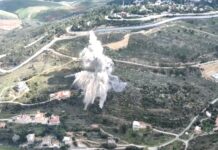Israel’s Counter-UAV Technologies: Securing the Skies
Tamir Eshel
Israel was among the first nations to recognise the potential threats of unmanned aviation, particularly from Iran and its proxies in the region. Consequently, over the past several decades, Israel has solidified its reputation as a leader in the unmanned aviation sphere.
Since the Second Lebanon War in 2006, Iran has conducted drone attacks from Lebanon, Syria, Iraq, and Iran. Although few have penetrated Israel’s airspace, with few such cases compared to rocket strikes launched by Lebanese and Palestinian non-state armed groups. Yet these incidents still exposed a capability gap that Israel sought to address. Israel has focused on neutralising the Iranian drone threat by implementing doctrinal changes, operations, and techniques. Technological advancements now address drone dangers at various operational levels. Nevertheless, the dramatic proliferation of unmanned aerial vehicles (UAVs) and loitering munitions (LMs) reflects lessons learned by both sides in the war in Ukraine, stemming from the Iranian deployment of advanced drones in support of Russia, and the significant military potential of dual-use drone technology, as demonstrated by the Ukrainian side. Today, Israel is prepared and equipped to confront the ever-evolving and imminent drone threat, despite the exponential growth in adversarial capabilities.
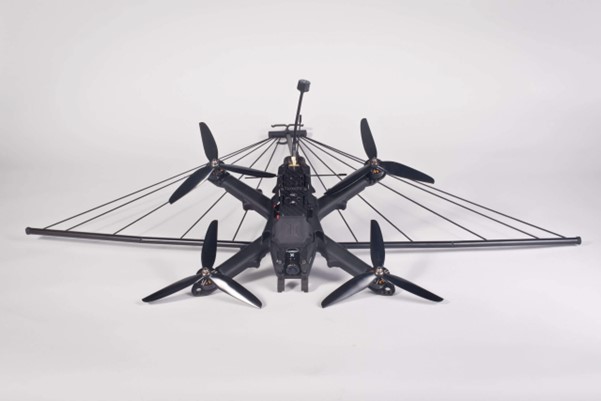
Credit: Xtend
An Evolving Threat
The threat posed by UAV is continuously evolving. Historically, UAVs, along with precision-guided bombs and missiles, represented asymmetric capabilities reserved for developed, primarily Western nations combating irregular forces, such as insurgents or terrorists. This characterisation may have been accurate until the early 2000s, but it is no longer realistic. With the entry of China and Iran into the UAV arena, specifically regarding LMs, military and paramilitary forces have gained access to advanced aerial capabilities with unprecedented potential.
Iran has emerged as a capable UAV developer, introducing and deploying new capabilities regularly. Iran also garners extensive combat experience with these systems, which offers valuable feedback for developing new capabilities to challenge adversaries. Iran’s arsenal now includes tactical drones capable of operating over hundreds of kilometres on reconnaissance and attack missions, large jet-powered drones for fast, long-range missions carrying large air-dropped bombs, low-observable platforms primarily used for reconnaissance, and autonomous drone-based ‘mini-cruise missiles’. The latter ‘dark drones’ do not rely on data links or satellite navigation (GPS), rendering them virtually immune to electronic attacks. LM utilise autonomous guidance or remote operation to home in on specific targets. LM often employ a communication channel and seekers, enabling operators to select and designate targets for the drone to pursue. This communication link allows drones to operate in coordinated groups or swarms, presenting a more formidable challenge to defenders.
Iranian drones have been deployed in Syria, Iraq, and Yemen, where they have honed advanced operational concepts using various types and multiple drones in simultaneous attacks. Iranian drones have also been extensively used by Russian forces in Ukraine, resulting in devastating attacks. Israel also faces ongoing challenges from these drones supplied to Iranian proxy organisations in its own region.
Another developing threat is the militarisation of commercial drones, a trend observed in Ukraine. Inexpensive, do-it-yourself (DIY) drones constructed from commercially available kits are repurposed into attack platforms. These range from small hobbyist drones used for intelligence gathering and artillery spotting to larger drones that carry multiple grenades or small bombs dropped by operator command, and even fast, highly manoeuvrable racing drones rigged with a single warhead utilising ‘first person view’ (FPV) to become a guided missile that hunts, chases, and strikes moving targets.
The war in Ukraine has unleashed a DIY Pandora’s Box, setting a precedent for non-state armed groups to harness this advanced technology for future use. These technologies provide both a means for conducting reconnaissance and delivering strikes. The latter can be amplified by targeting hazardous, flammable, and explosive materials to achieve secondary effects, striking high-value targets, or deploying drones in diversionary attacks as part of larger operations.
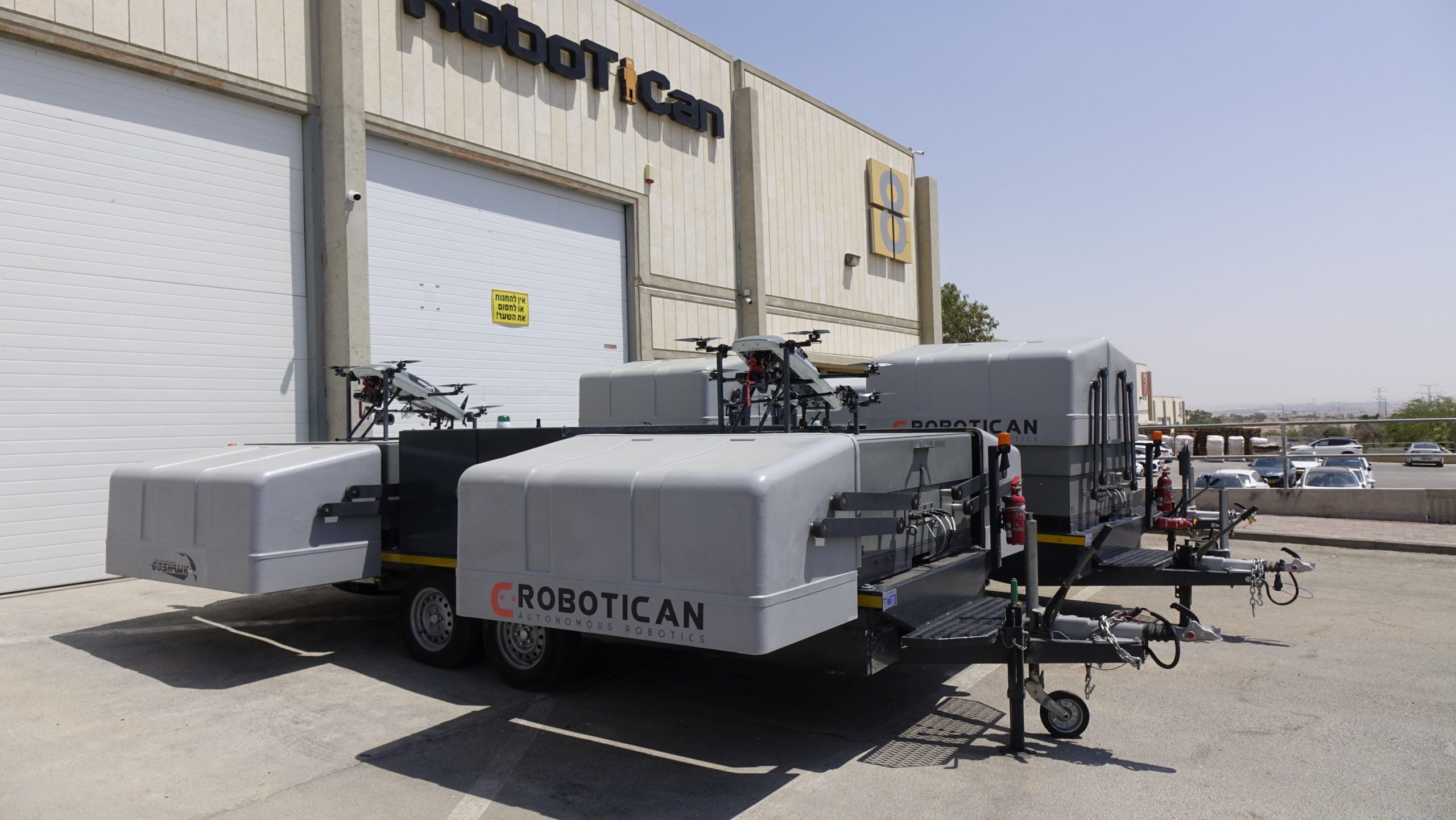
Credit: Robotican
Managing Drone Traffic
Moving forward, an important factor to consider is the increasing volume of commercial drone activity as users adopt drone technology for various applications. Detecting and locating low-flying rogue drones or drone swarms within airspace congested by commercial activity necessitates automated unmanned traffic management (UTM) systems to oversee all authorised drone activity in a country. The Israeli start-up company High Lander developed such a system, which was tested this year by one of the Israel Air Force (IAF) Air Control Centres. The company was also selected to provide UTM capabilities to Israel’s national police force.
Airspace management is only one aspect of controlling UAV activity at low altitudes. The drone threat is too complex to be addressed by a single solution, and it is challenging to determine which entity is responsible for providing the solution. Should it be the military, the police, the Ministry of Transportation, an aviation authority, or an internal security agency? This remains an open question in Israel. While some sectors are covered—the Israel Defense Force (IDF) and Air Force have implemented solutions, as has the airport authority as part of their ongoing security plans, but not the country as a whole. The Israeli Ombudsman’s office recently reported that the country has yet to adopt more comprehensive protection against drones. Fortunately, there is no shortage of Israeli technological solutions.
When tasked with dealing with drones, various entities employ different means. Civilian organisations, such as security companies protecting VIP residences, office buildings, commercial sites, mass gatherings, municipal operators, and government agencies responsible for transportation or public services, focus on safeguarding specific areas or activities from intentional or unintentional drone interference. They aim to detect any drone activity over the protected area and deny unauthorised operators access. Equipment for these agencies is often limited to commercially available systems and services. As for mitigation, taking down a seemingly ‘hostile’ target could be considered illegal when protecting civilian and commercial spaces. It may result in lawsuits from individuals exposed to damage or harm by the drone or countermeasures against it. Consequently, such enforcement should be measured and scalable, minimising collateral damage.
C-UAV Situational Awareness
Israeli manufacturers IAI/Elta Systems, Elbit Systems, and Leonardo DRS (formerly RADA) offer ground-based radars designed or optimised for C-UAV missions. These radars employ Active Electronically Scanned Array (AESA) radars and micro-Doppler signal processing techniques to efficiently detect and track multiple slow-flying, low-altitude targets at ranges of several kilometres over a 90° sector. Several units can be combined for full 360° coverage. While DRS offers its radar as a component integrated by other manufacturers, such as Rafael’s Drone Dome, Elbit Systems and Elta provide their radars as part of their own C-UAV solutions. Introduced in 2022, Elbit Systems’ DAiR radar can detect hundreds of targets, including small drones and humans, at 12–15 km ranges. It is compatible with the All-purpose Structured EUROCONTROL Surveillance Information Exchange (ASTERIX) protocols, enabling seamless information sharing with C4I systems.
Elta Systems offers tactical C-UAV capabilities with its ELI-2139 Green Lotus system, a multi-sensor system designed for tactical low-tier ground-based air defence (GBAD), counter-UAV (C-UAV), and counter-rocket, artillery & mortar (C-RAM) missions. This modular solution combines S- and X-Band radars, VHF/UHF direction-finders/ communications intelligence (COMINT) systems, as well as a day and infrared (IR) optoelectronic sight. The mobile system is capable of automatically detecting, tracking, classifying, and identifying, a wide variety of aerial targets, including fighter aircraft, helicopters, UAVs, drones, and low radar cross section (RCS) targets such as missiles, rockets, artillery, and mortar shells. It is also capable of detecting and classifying ground targets, such as vehicles and slow-moving persons. All multi-sensor data is collected and processed within the system’s unified command and control (C2) console, which automates detection, classification, and identification to provide a comprehensive situational awareness picture (SAP).
Optoelectronic sensors are also employed to identify drones; typically, they are triggered by other detection and tracking systems, such as radars and electronic surveillance systems. Combined with radars, these sensors serve as validation technology to reduce false detections and classify and verify targets. Sophisticated optronic IR cameras identify drones based on visual and temperature-related identifiers, ensuring that detected objects are actually drones. Optronic systems can support detecting and verifying UAV targets at extremely long ranges, particularly when engaging fixed-wing, high-flying drones detectable by radar but requiring tracking assistance from other systems. Controp recently introduced a comprehensive range of optronic systems for mobile, deployable, and fixed C-UAV and air defence applications under the I-TACT product line. Optimised for spotting and tracking low-signature targets, the I-TACT line provides passive scanning, classification, and tracking of drones at ranges from 6-40 km or small drones at 1-6 km. I-TACT can be integrated into existing optronic systems with the performance level required for detection, recognition, and identification (DRI) at range. Enhanced image processing capabilities improve the I-TACT system’s performance, allowing the system to focus on specific regions of interest in the picture to improve target recognition, automatic flight path prediction, and tracking, enabling users to improve their passive UAV detection and engagement.
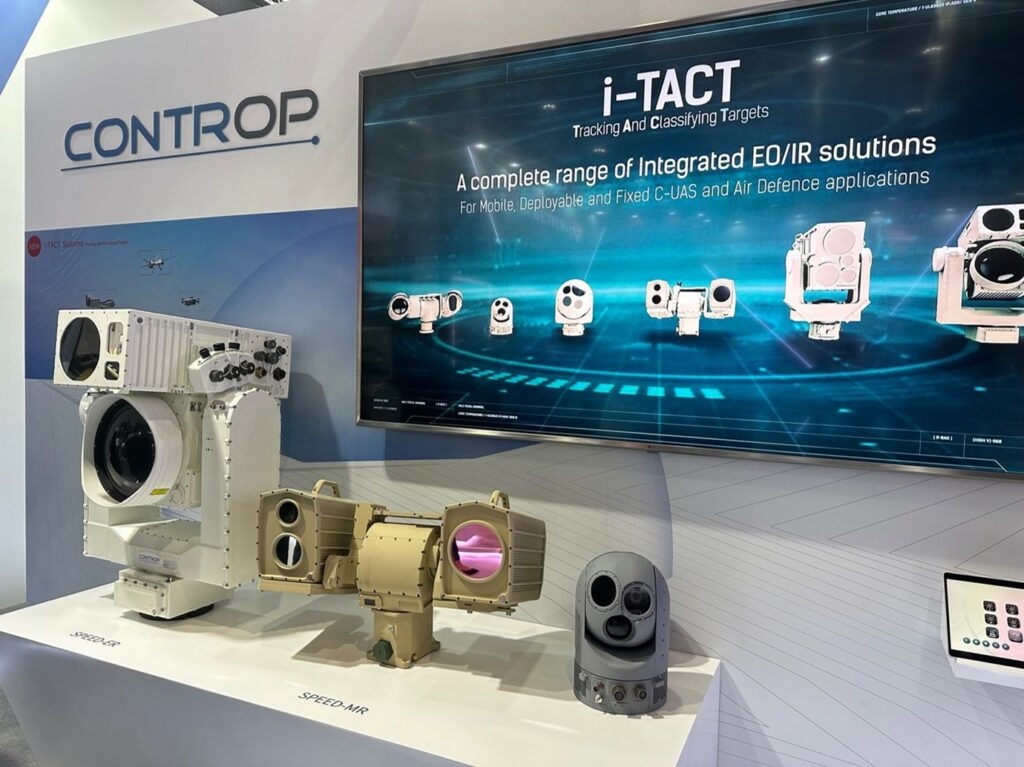
Drone Guards
Numerous C-UAV systems developed by Israeli companies for civilian and military applications utilise passive and active sensors for early warning, detection, classification, and situational awareness. One of the pioneering systems in Israel, the Elta ELI-4030 Drone Guard, features an open system architecture, enabling the integration of various sensors and effectors such as radars, passive COMINT, and optronic systems for target detection and verification.
The C2 System used by Drone Guard unifies all functions into a single system and employs automated threat analysis and AI-based decision-making tools, decreasing operator workload and allowing the system to be crewed by relatively few operators, even in high-demand scenarios. Drone Guard offers numerous threat mitigation methods, including target flight control takeover via cyberattack, communication and navigation (GPS) protocol disruption through jamming, or engagement with a weapon system. Other potential interception methods which can be integrated include drone-deployed disruptive measures, and accurate stabilised fire from various weapons mounted on remote weapon stations (RWSs). Using an optimal sensor and effector configuration, Drone Guard can detect and track drones up to 40 km away, identify targets up to 20 km away, and neutralise selected targets up to 10 km away.
Scanning the electromagnetic spectrum for rogue drones is an effective surveillance method against remotely controlled or monitored drones. D-Fend Solutions’ EnforceAir system uses passive receiver antennas to detect the unique communication signals commercial drones use within an area. The received telemetry signals can be decoded to determine information such as the drone model, current position, and position at take-off. This information can also be used as part of responses against the operator, and for conducting a remote cyber-takeover of the drone. Radio Frequency (RF) cyber-takeover techniques are tailored to overcome specific protocols of commercial or DIY drones. The system automatically executes RF cyber-takeovers of drones, forcing them to perform a safe landing and minimising the risk of collateral damage. These cyber solutions are particularly suited to urban areas, as they do not require direct line of sight.
Drone-Kill-Drone Solutions
When more forceful means of interception are required, then ballistic nets, chaff projectiles, or so-called ‘Drone-Kill-Drone’ (DKD) solutions are utilised. Some DKD solutions use expendable or reusable kinetic drones, while others use deployable armaments carried by drones. An example of the latter capabilities is the Iron Drone from Airobotics, which is designed to defend assets against hostile drones in complex environments with minimal collateral damage. As a fully automated solution, it uses the Raider, a small interceptor drone. During an intercept, Raider flies autonomously towards its designated target, tracking the target automatically using a day/night camera provided with computer vision software, and deploys a ballistic net to incapacitate the rogue drone, with the net subsequently deploying a parachute to and safely lower the target to the ground.
Another Israeli C-UAV system utilising the DKD concept is Robotican’s Goshawk, an autonomous system employing a drone which deploys an arresting net to capture hostile drones in mid-air. Capturing the rogue drone allows Goshawk to perform controlled disposal of the captured drone at any chosen location, such as an explosive pit for a weaponised drone, or a safe site for further inspection. Its relatively minimal potential for collateral damage makes Goshawk suitable for operation in populated areas and high-risk locations.
When a rapid response is crucial and minimal facilities are available to handle the situation, the Xtend Griffon enables an operator to deploy a fast interceptor drone system. The Griffon comprises a drone with an underslung net mounted on a rigid frame. Upon capture of the target drone, the net is detached and falls to the earth with the target. The control system employs virtual reality and sensor fusion technologies, which provide the operator with assistance enabling them to conduct semi-automated interceptions. This allows an operator with no flight experience to use the system.
Other kinetic C-UAV interceptors use drones which rely on hit-to-kill for target defeat. Skylock, a C-UAV solution provider, employs two kinetic intercept methods – the DRONELOCK, a quad-rotor drone which autonomously intercepts hostile drones by ramming them, relying on the force of the kinetic impact to down the target. DRONELOCK leverages proprietary onboard AI and machine vision processing to track its targets. On the rapid interception side, Skylock offers the Sky Interceptor, which is essentially a rocket equipped with a non-explosive ‘countermeasure cloud’ warhead and proximity fuze. The warhead contains a condensed mesh of thin rubber strips, and upon activation, the warhead releases these strips into a large countermeasure cloud, which will entangle the propellers of any drone present within or passing through it, and thereby causing it to crash. The countermeasure cloud covers a relatively wide area, enabling the system to engage drones performing evasive complex manoeuvres and drone swarms. Effective at ranges of 1-3 km, Sky Interceptor rockets can be launched from ground or aerial platforms.
Lethal Countermeasures
Some sophisticated drones may be immune to cyber-takeover or soft-kill solutions, leaving the hard-kill option as the only way to prevent a drone attack. Using common small arms against drones is extremely difficult, requiring luck, good visibility and eyesight, favourable wind conditions, and sniper-like weapon control. To simplify this task, SmartShooter developed the SMASH family of fire control systems, which enable operators to engage moving targets such as UAVs using standard firearms fitted with the system. The SMASH range of small arms fire control systems essentially comprise a traditional small arm optic integrated with cameras, a laser rangefinder, a tilt sensor, a meteorological sensor, and a fire control computer with computer vision and ballistic calculation. The system operates by the user designating a target, following which the system tracks the target and continually calculates an optimal point of aim to ensure a hit on that target. This is displayed on the sight, informing the operator where to aim their weapon. The operator is then free to pull the trigger, however the system electronically locks firing pin release until the weapon’s point of aim aligns with the optimal point of aim set by the fire control computer. This arrangement makes it much easier to engage moving targets such as UAVs with small arms.

Another solution embedded into RCWS is General Robotics’ Pitbull-AD, a RWS fitted with soft-kill effector in the form of the DroneShield DroneCannon jammer, and the hard-kill component consisting of a 7.62 mm or 5.56 mm machine gun. The fire control system is capable of automatic target detection, tracking and recognition, as well as establishing fire inhibition zones.
Addressing the need for C-UAV for naval vessels, Rafael has optimised the capabilities of its TYPHOON Mk 30-c naval RWS defeat UAVs out to ranges of 3,000 m. The use of airburst ammunition and improvements to the original system’s automatic target recognition and fire correction are offered as an upgrade for existing TYPHOON users.
Rafael also offers a high-energy laser (HEL) effector as part of its Drone Dome C-UAV system. The HEL interceptor can be used as a complementary measure, with the advantages of engagement at the speed of light, unlimited magazine capacity, and negligible cost per interception. LITE BEAM is a 7.5 kW HEL intended for use against small drones, as well as ground targets such as improvised explosive devices (IEDs) and unexploded ordnance (UXO). It is capable of engaging targets from ranges of a few hundred metres out to 2,000 m.
As drone technology continues to proliferate, Israel, as with others, must adapt to address these evolving threats. C-UAV capabilities remain a primary concern for local authorities, government agencies, and defence, security, and commercial sectors. As such, their countermeasures are anticipated to remain in the spotlight for the foreseeable future.
Tamir Eshel





